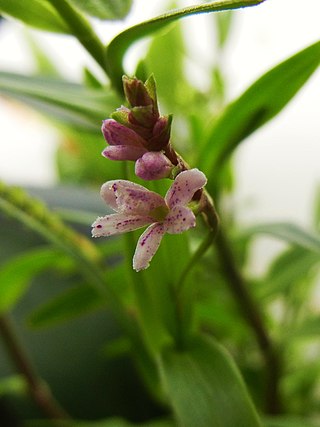Bulbophyllum tokioi is a species of plant in the family Orchidaceae. It is endemic to Taiwan. It was described in 1935 by Noriaki Fukuyama.

Epidendrum armeniacum is an epiphytic species of reed-stemmed Epidendrum orchid that grows wild in Bolivia, Brazil, Ecuador, and Peru, at altitudes of 1–2 km.

Epidendrum macrocarpum, widely known as Epidendrum schomburgkii, is a species of orchid in the genus Epidendrum, and the largest-flowering crucifix orchid species. Reichenbach thought that E. fulgens and E. schomburgkii var. confluens were both synonyms for this species.
Epidendrum polystachyumHBK (1816) is an epiphytic orchid, which grows wild in seasonally dry forests on the western slopes of the Andes in Ecuador and Peru at altitudes near 2 km.

Gastrochilus distichus is a small species of orchid and pendant growing epiphyte. It is known by the common name distichous gastrochilus. It is found in Himalayas of India, Nepal, Bhutan, Assam, Sikkim, Tibet and Yunnan. It grows in the shade on moss covered rainforest at elevations of 1520–2700 m.

Epidendrum rigidum is an epiphytic reed-stemmed Epidendrum orchid common throughout the Neotropical lowlands, below 600 m (2,000 ft).

Orchis provincialis, the Provence orchid, is a species of orchid in the genus Orchis.

Phalaenopsis philippinensis is an endemic species of orchid found from Luzon island in the Philippines.
Bulbophyllum cogniauxianum is a species of orchid in the genus Bulbophyllum found in Brazil.

Bulbophyllum cruciatum is a species of orchid in the genus Bulbophyllum found in Papua, Papua New Guinea, Seram Island, and Maluku Islands.
Bulbophyllum xanthornis is a species of orchid in the genus Bulbophyllum.
Epidendrum adenoglossum is an orchid known primarily from its type herbarium specimen, Mathews 1073, collected in Peru near Pangoa. When Lindley published the name, he placed the species in the subgenus E. subg. SpathiumLindl. (1841). In 2005, Hágsater & Soto designated this species as the lectotype of E. subg. SpathiumLindl. (1841).

Epidendrum coriifolium is a sympodial orchid which grows both terrestrially and epiphytically at altitudes of 1.4—1.7 km in dense forests in Brazil, Ecuador, Mexico, Central America, and Venezuela.

Epidendrum cylindrostachys is an epiphytic orchid native to the mountainous rainforest of Colombia and Peru, at altitudes near 2.5 km. According to the World Checklist, this binomial has no synonyms or homonyms.

Epidendrum fimbriatum is a terrestrial orchid native to high altitudes (2.2—3.4 km) in Bolivia, Colombia, Ecuador, Peru, and Venezuela.
Epidendrum geminiflorum is a tropical epiphytic orchid native to Colombia, Ecuador, Peru, Suriname, and Venezuela at elevations of 2.3—2.9 km.

Aa calceata is a species of terrestrial orchid in the genus Aa. It is thought to be endemic to Bolivia, though there are unconfirmed records of the plant in Peru.

Vanda wightii is a species of orchid from southern India and Sri Lanka. For some time it was thought to be extinct after being described in 1849. The species was however rediscovered and it is now known from India. It is closely related to Vanda thwaitesii. The species was named by Reichenback after the botanist and collector Robert Wight. 1.

Lepanthes kokonuko is a species of orchid from southern Colombia. L. kokonuko can be easily recognized by its caespitose medium-sized plants, elliptical coriaceous leaves, long loosely, flexuous and distichous inflorescences; strongly revolute lateral sepals, transversely bilobed petals with the upper lobe lanceolate (hornlike), and a bilaminate lip with the blades ovoid–lanceolate with a bipartite appendix.

Crateva tapia, commonly known as toco, payaguá, naranjuelo, or beach apple, is a member of the genus Crateva, belonging to the family Capparaceae. It is native from Mexico through Central America into South America as far as south Brazil.













